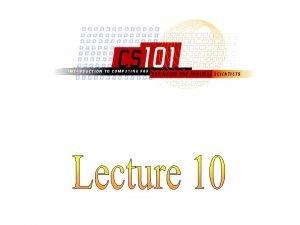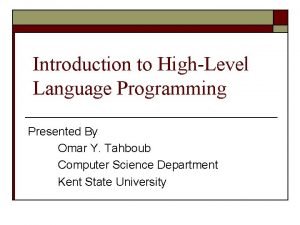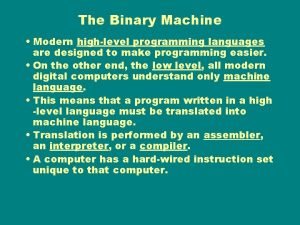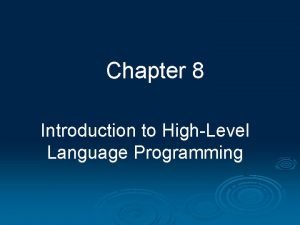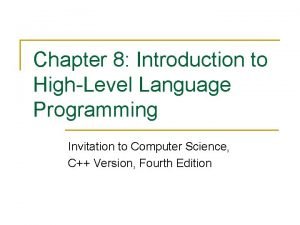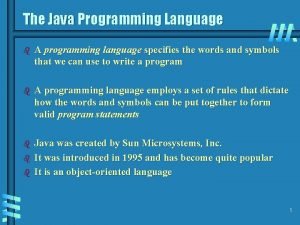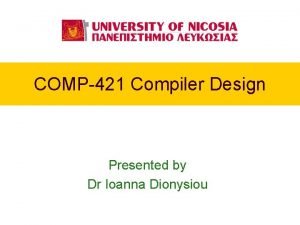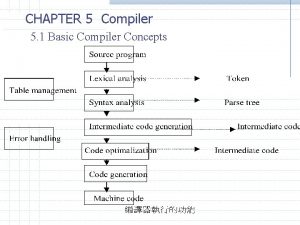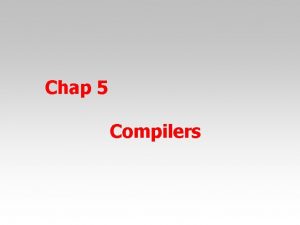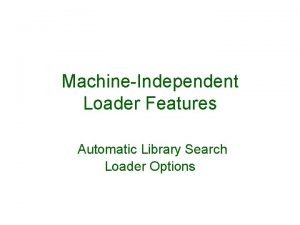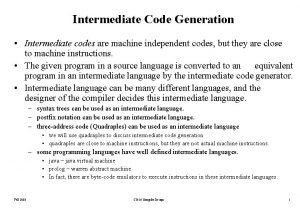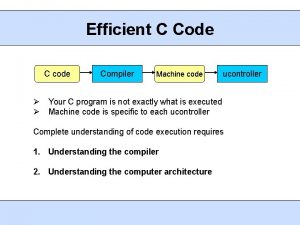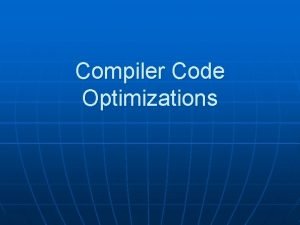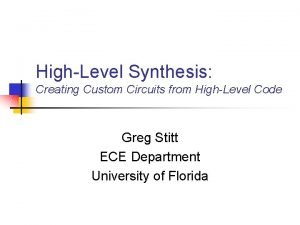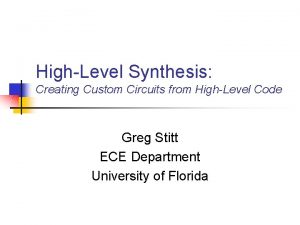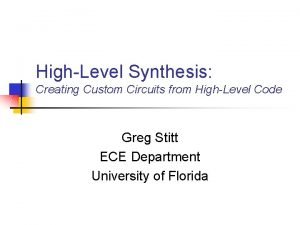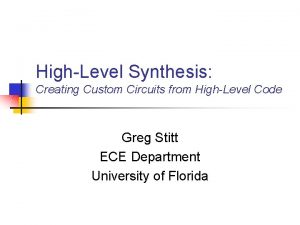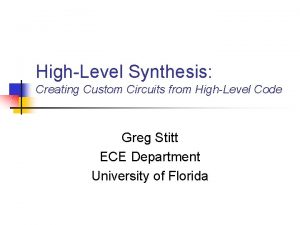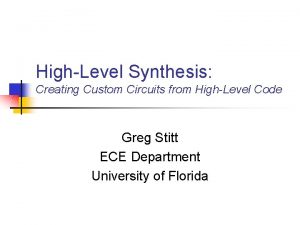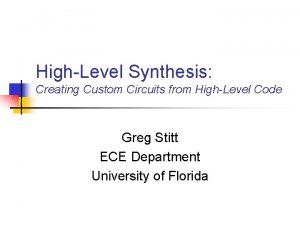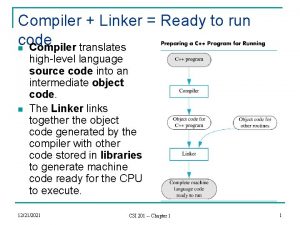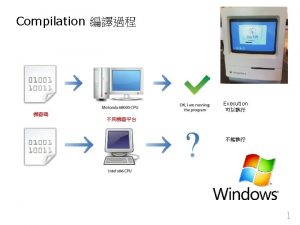Highlevel View of a Compiler Source code Machine













- Slides: 13

High-level View of a Compiler Source code Machine code Compiler Errors Implications • • Must recognize legal (and illegal) programs Must generate correct code Must manage storage of all variables (and code) Must agree with OS & linker on format for object code from Cooper & Torczon 1

Traditional Two-pass Compiler Source code Front End IR Back End Machine code Errors Implications • • Use an intermediate representation (IR) Front end maps legal source code into IR Back end maps IR into target machine code Admits multiple front ends & multiple passes (better code) Typically, front end is O(n) or O(n log n), while back end is NPC from Cooper & Torczon 2

A Common Fallacy Fortran Front end Scheme Front end Java Front end Smalltalk Front end Back end Target 1 Back end Target 2 Back end Target 3 Can we build n x m compilers with n+m components? • Must encode all language specific knowledge in each front end • Must encode all features in a single IR • Must encode all target specific knowledge in each back end Limited success in systems with very low-level IRs from Cooper & Torczon 3

The Front End Source code Scanner tokens IR Parser Errors Responsibilities • • • Recognize legal (& illegal) programs Report errors in a useful way Produce IR & preliminary storage map Shape the code for the back end Much of front end construction can be automated from Cooper & Torczon 4

The Front End Source code Scanner tokens IR Parser Errors Scanner • Maps character stream into words—the basic unit of syntax • Produces words & their parts of speech x = x + y ; becomes <id, x> <op, = > <id, x> <op, + <id, y> ; > word lexeme, part of speech token > In casual speech, we call the pair a token • Typical tokens include number, identifier, +, -, while, if • Scanner eliminates white space • Speed is important use a specialized recognizer from Cooper & Torczon 5

The Front End Source code Scanner tokens IR Parser Errors Parser • Recognizes context-free syntax & reports errors • Guides context-sensitive analysis (type checking) • Builds IR for source program Hand-coded parsers are fairly easy to build Most books advocate using automatic parser generators from Cooper & Torczon 6

The Front End Compilers often use an abstract syntax tree - + <id, x> <id, y> The AST summarizes grammatical structure, without including detail about the derivation <number, 2> This is much more concise ASTs are one form of intermediate representation (IR) from Cooper & Torczon 7

The Back End IR Instruction Selection IR Instruction Scheduling IR Register Allocation Machine code Errors Responsibilities • Translate IR into target machine code • Choose instructions to implement each IR operation • Decide which value to keep in registers • Ensure conformance with system interfaces Automation has been much less successful in the back end from Cooper & Torczon 8

The Back End IR Instruction Selection IR Instruction Scheduling IR Register Allocation Machine code Errors Instruction Selection • Produce fast, compact code • Take advantage of target features such as addressing modes • Usually viewed as a pattern matching problem > ad hoc methods, pattern matching, dynamic programming This was the problem of the future in 1978 > Spurred by transition from PDP-11 to VAX-11 > Orthogonality of RISC simplified this problem from Cooper & Torczon 9

The Back End IR Instruction Selection IR Instruction Scheduling IR Register Allocation Machine code Errors Instruction Scheduling • • Avoid hardware stalls and interlocks Use all functional units productively Can increase lifetime of variables (changing the allocation) Optimal scheduling is NP-Complete in nearly all cases Good heuristic techniques are well understood from Cooper & Torczon 10

The Back End IR Instruction Selection IR Instruction Scheduling IR Register Allocation Machine code Errors Register allocation • • Have each value in a register when it is used Manage a limited set of resources Can change instruction choices & insert LOADs & STOREs Optimal allocation is NP-Complete (1 or k registers) Compilers approximate solutions to NP-Complete problems from Cooper & Torczon 11

Traditional Three-pass Compiler Source Code Front End IR Middle End IR Back End Machine code Errors Code Improvement (or Optimization) • Analyzes IR and rewrites (or transforms) IR • Primary goal is to reduce running time of the compiled code > May also improve space, power consumption, … • Must preserve “meaning” of the code > Measured by values of named variables from Cooper & Torczon 12

The Optimizer (or Middle End) IR O pt 1 IR O pt 2 IR O pt 3 IR. . . O pt n IR Errors Modern optimizers are structured as a series of passes Typical Transformations • Discover & propagate some constant value • Move a computation to a less frequently executed place • Discover a redundant computation & remove it • Remove useless or unreachable code from Cooper & Torczon 13
 Difference between source code and machine code
Difference between source code and machine code Highlevel language
Highlevel language Highlevel programming language
Highlevel programming language Highlevel language
Highlevel language Highlevel language
Highlevel language Java compiler translates java source code into
Java compiler translates java source code into Yacc tutorial
Yacc tutorial Cross compiler in compiler design
Cross compiler in compiler design Calling sequence in compiler design
Calling sequence in compiler design Code commit code build code deploy
Code commit code build code deploy Compiler concepts
Compiler concepts Functions of compilers
Functions of compilers Which is a machine independent loader features
Which is a machine independent loader features Intermediate code example
Intermediate code example
